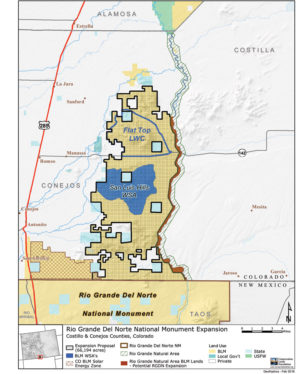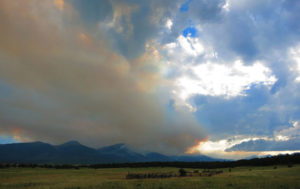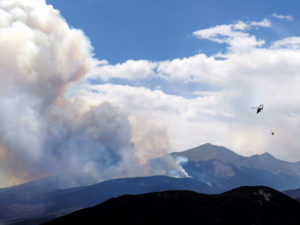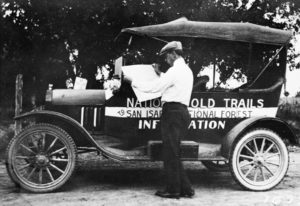By George Sibley
I’ve been trying to figure out Colorado. I’m always a little irritated when I’m driving through the Upper Arkansas Valley, on my way to the Upper Gunnison, and I see one of those signs: “Now this is Colorado.” Sez who? And is my Upper Gunnison also “really Colorado” even though it is somewhat different ecologically and economically from the Upper Ark? What is “real Colorado?”
This question rose again when I was invited to speak to the “Writing the Rockies” conference this month at Western State Colorado University; I decided to begin an exploration of what is “really Colorado.”
There’s no need of a real map of Colorado because you can all picture it in your minds: a simplistic rectangle imposed over some of the most diversely complex geography on the planet. Myself, I visualize that map as a blanket draped over a fence, covering more than it shows.
Within those rectangular lines, meaningful only to ships at sea, are at least five distinct ecologies and economies, each with its own culture. Some years ago, the Colorado Humanities Council defined and described “Five Colorados” as distinct cultural entities. I’m thinking along similar lines, but with some variations.
The whole eastern third of the state – basically everything east of Aurora – is the High Plains, a drier continuation of the Great Plains that stretch all the way from the Mississippi River, big-farm country with a residual agrarian culture that’s being overrun by agribusiness. That Colorado’s cultural affinity is the Midwest.
On the other side of the state – the westernmost part of the rectangle, including the San Juan Basin on the southern edge, is part of the high orographic desert of the Colorado Plateau – a canyon-cut steppe-desert where Indian and Mormon cultures coexist.
And the southeastern quadrant of the state, the Rio Grande Basin and the Arkansas Basin south of the river, is high desert segueing into the subtropical deserts, a region whose cultural compass has been pointed toward Old and New Mexico much longer than there has been a Colorado or United States.
Those three Colorados are all culturally bonded to the larger ecologies and economies from which they have been artificially sliced by the abstract Colorado boundaries. They are only bonded together as Colorado by enforced state governance – and also through highly ambiguous relationships with a fourth Colorado: the metropolitan cluster of growing cities and suburbs along the edge of the mountains that we tend to call Denver, Colorado, a city related to both mountains and plains in the same way a port city is related to the ocean. Four out of every five Coloradans live in that growing metro complex, and the other one-in-five of us have a serious love-hate relationship with it. We love the Broncos and Rockies the cities support, and we all continue to have an embarrassing near-total dependency on the trucks that roll out from the city on schedule to bring us almost everything we need to live in the rest of the state. But we also all fear the needs and demands of the cities, especially for water.
[InContentAdTwo]
If you are watching the map in your mind carefully, however, you know there is yet another Colorado – here, the mountain part of the state, Colorado above, say, 6,000 feet elevation? So far as I’m concerned, this is what’s “really Colorado,” the true Colorado. Some come here thinking they have come to “the middle of nowhere,” but where you are here is actually the middle of everywhere, everything, at least for the southwestern quadrant of that larger abstraction called the United States of America. This is where the water starts for that whole quadrant, and where the water starts is where life starts, where everything starts. And it is where Colorado started as a state of mind before it was ever a culturally incoherent rectangle on the map.
To truly understand what is “really Colorado,” we need to understand the name itself. Colorado is a Spanish adjective, not a noun, which makes it a bit odd for the name of a place. But we persist – even insist – on mistranslating it. Ask any Coloradan today how colorado translates to English, and they will probably say “red.”
But isn’t rojo “red” in Spanish? Yes. And dig into colorado a little, with a spoon and not a steam shovel, and you find a much more obvious and expansive meaning. In an internet discussion of this very topic, one participant drew on the authority of the Spanish Royal Academy Dictionary to declare that “red or reddish is just a secondary meaning of colorado. As the word’s root itself suggests, colorado means, primarily, “having color”, any color.” Colorful, full of color.
All the sandstone certainly makes red one of the colors of colorful Colorado – Colorado colorado. But to begin to understand Colorado colorado as a state of mind – what is “really Colorado” – you need to go back a year before the rectangular Colorado Territory was conceived, back to 1859 when the crazy Americans known as prospectors were swarming up every stream in the central Southern Rockies, all the way across the Great Divide to our West Slope valleys, swirling gravel in flat pans until they came to places that were “showing color” – and the color they sought of course wasn’t red; it was gold. Gold and silver were the original colors infusing the state of mind that drove otherwise intelligent young men and old to leave their former lives behind and flock up the wild rivers and streams of mountain Colorado.
We know that Colorado has many other colors. The reds, blues and shadows of the mountains, often capped in white. The vast textured slopes of dark green conifer forest and light green aspen forest. The high meadows with their paisley carpets of flowers. The lower gray-green meadows dropping down to soft green floodplains, laced by the meandering rivers seasonally running from clear green-brown to muddy red, fed by the whitewater mountain creeks.
In the beginning, in that first basement epoch of Colorado as a state of mind, Colorado’s other colors were not just ignored, they were in the way of the search for gold and silver. Whole hills were washed away in hydraulic mining; forests that weren’t cut down for boomtown lumber were burned to expose rock outcrops; dredges literally plowed rich green floodplains into intestinal coils of sterile gray rubble. Streams and rivers occasionally still “show color” from that mining heritage. The first colors, the gold and silver, all disappeared into Denver banks and mansions. The gray-brown mess, however, lingers on into the present.
We should note that Colorado does rhyme with “Eldorado,” the fabulous land of gold supposedly richer than the already pillaged cities of Mexico and Peru, and somewhere here north of Mexico were supposed to be the equally fabulous Seven Cities of Cibola. The Spanish had come armed with sword, cross and crossbow on the assumption that these golden places actually existed, to be conquered and plundered in the name of god and king. The more democratic Anglo-Americans, on the other hand, came a couple centuries later armed with shovels, picks and saws, as if assuming that the Seven Cities were a do-it-yourself project, with fabulous wealth for those who got in on the ground floor.
The very vagueness of those Eldoradan visions may have been their best selling point, and the state of mind of those who came may have been infused mostly by the vague hope that life here would be somehow better, richer or at least more interesting than what they were leaving behind – “back in the States” as they used to say, as though the West were a different country. And the more vague the vision, the better it weathered the hard rains of reality; people kept coming, knowing only that they were looking for something they didn’t have where they were coming from.
And it may be that my hypothesis is just a hope that the borderline craziness that brought me here, and has more or less kept me here, is a cultural thing and not just something wrong with me. But anyway, I raise the question again. What was the state of mind that led people – mostly single men at first, but single women too, and eventually families and groups of friends, and even immigrants from Europe and farther, to this relatively hard place of impossible implacable mountains and lovely but isolating valleys, way out on the fragile margin of civilization as we know it?
I defer that question to one of Colorado’s greatest poets, Belle Turnbull – a woman who graduated from Vassar, and ended her life happily with a longtime female companion in a rough cabin near Breckenridge. Turnbull asks that question better than I can:
Mountains cast spells on me –
Why, because of the way
Earth-heaps lie, should I be
Choked by joy mysteriously;
Stilled or drunken-gay?
Why should a brown hill-trail
Tug at my feet to go?
Why should a boggy swale
Tune my heart to a nameless tale
Mountain marshes know?
Timberline, and the trees
Wind-whipped, and the sand between –
Why am I mad for these?
What dim thirst do they appease?
What filmed sense brush clean?
I don’t know – but that is really Colorado.
George Sibley writes and thinks too much in the Upper Gunnison Valley.




